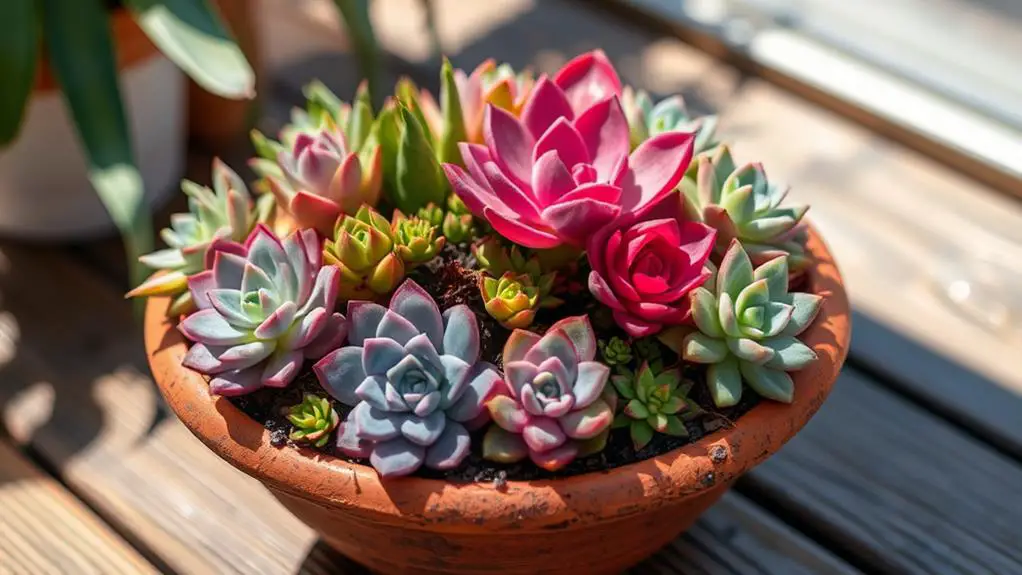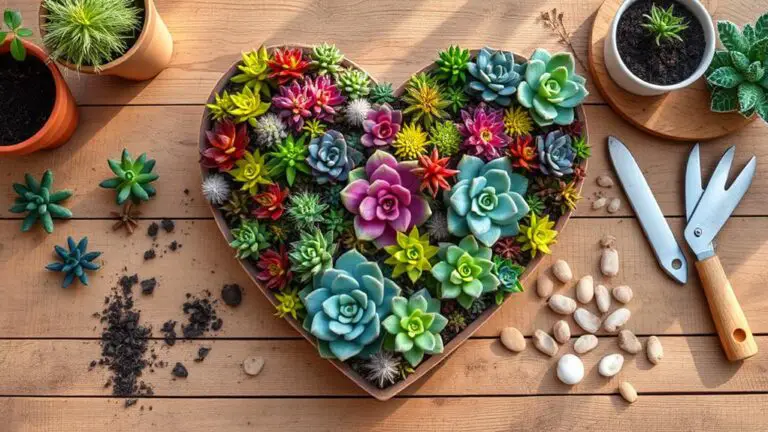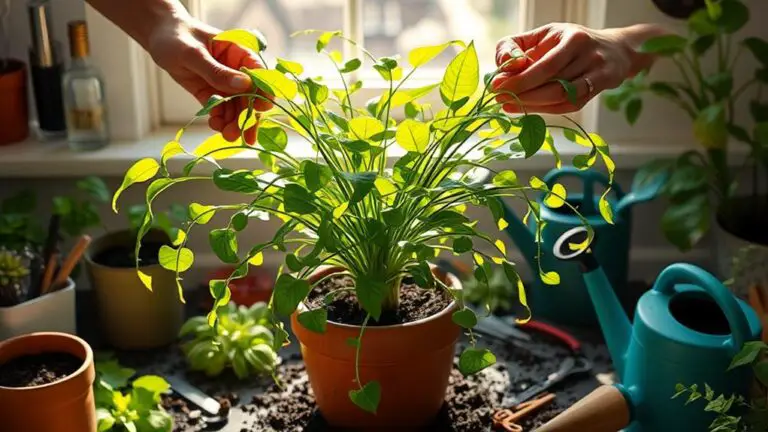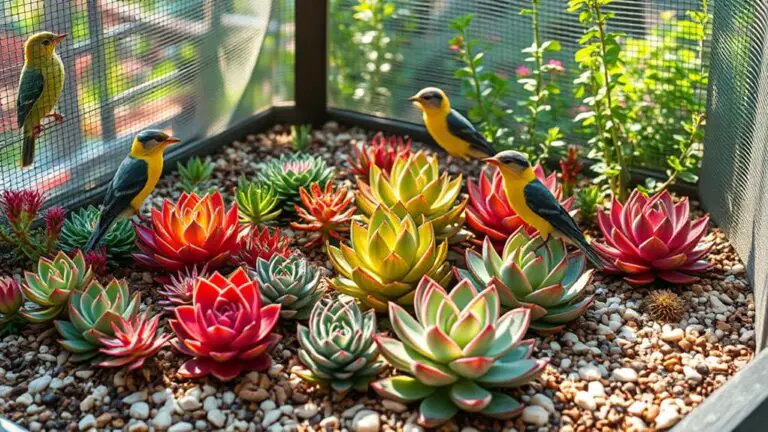Top 7 Tips to Choose Succulents for a Stunning Arrangement
Creating a succulent arrangement that stands out involves more than just picking a few plants and placing them in a pot. You need to choose the right varieties, considering their shapes and colors, and guarantee they have compatible light needs. The soil mix and container you select play essential roles in the health of your succulents. Planning the design thoughtfully, using decorative stones, and selecting unique planters can elevate the visual appeal. But how do you balance all these elements effectively? Let's explore each tip to help you craft a truly stunning arrangement.
Understand Different Succulent Types
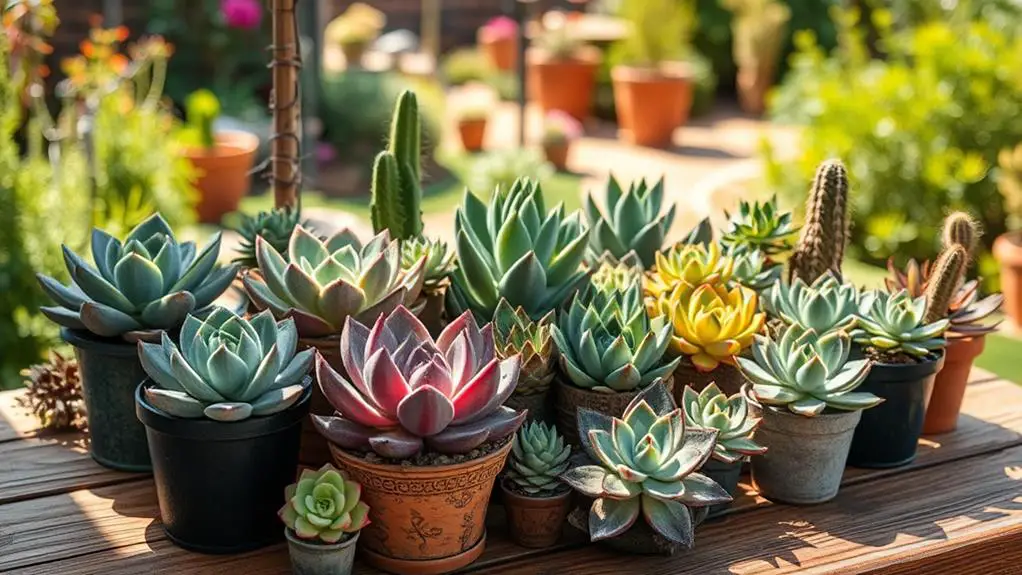
When choosing succulents for your arrangements, it's crucial to understand the different types available. Echeveria, with its vibrant rosette shape, adds color and charm.
Sedum offers tiny, stubby leaves that form attractive mats, perfect for ground cover. Aloe Vera, known for its thick, pointed leaves and healing gel, brings both function and beauty to your display.
The Jade Plant, with round leaves and thick stems, provides a classic look and structure. Consider mixing different succulent types with unique shapes and growth habits to create visual interest.
Think about how each plant's texture, like Aloe's smooth leaves and Agave's coarse ones, can make your arrangement pop. These thoughtful plant selections will enhance your succulent garden.
Consider Light Requirements
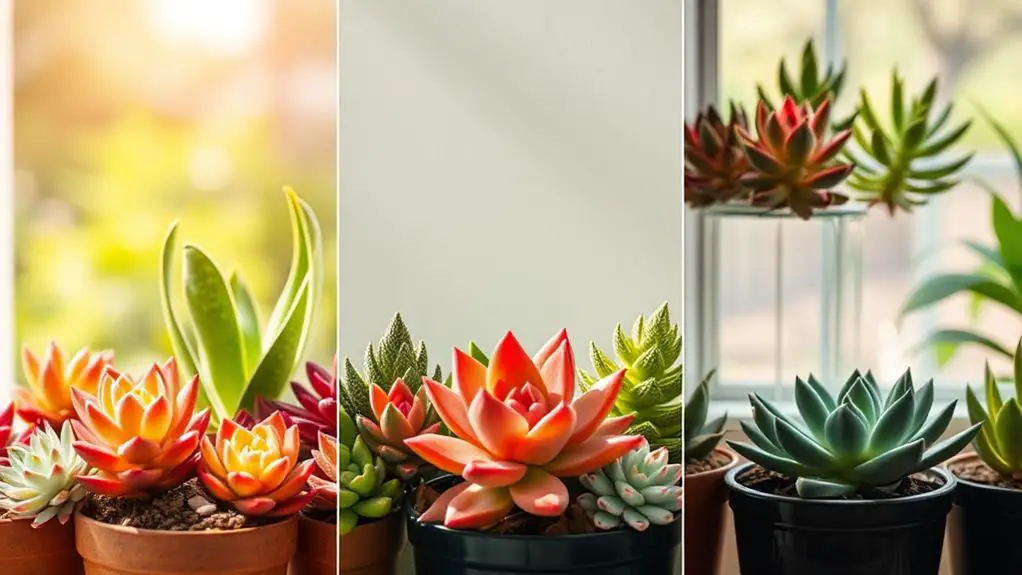
To create a thriving succulent arrangement, you must consider the light requirements of each plant. Most succulents need bright, direct sunlight for at least 6 hours daily. Assess your light conditions to guarantee you're providing what they need.
Plants like Echeveria and Aloe prefer full sun, while Haworthia and Gasteria thrive in bright indirect light. For indoor succulents, place them near bright windows or use grow lights to promote healthy growth.
Gradually acclimate your succulents to outdoor sunlight to prevent sunburn. Keep an eye on the leaves; shriveled or stretched leaves mean insufficient light, while scorched leaves indicate too much direct sunlight.
Choose the Right Soil

Selecting the right soil is essential for your succulent arrangement's success. Succulents thrive in well-draining soil to prevent root rot. Aim for a potting mix with 50% gritty materials like perlite or pumice.
Avoid heavy, moisture-retaining soils that can suffocate your plants. Instead, consider using a cactus mix or create your own by combining potting soil with sand or coarse materials.
Regularly check soil moisture levels, ensuring it dries completely between waterings. This helps support healthy root respiration.
Also, make sure your soil is rich in organic matter to provide essential nutrients while maintaining proper drainage. Commercial mixes may lack enough nonorganic content, so aim for about 60% nonorganic materials to support your succulents' ideal growth conditions.
Select Suitable Containers
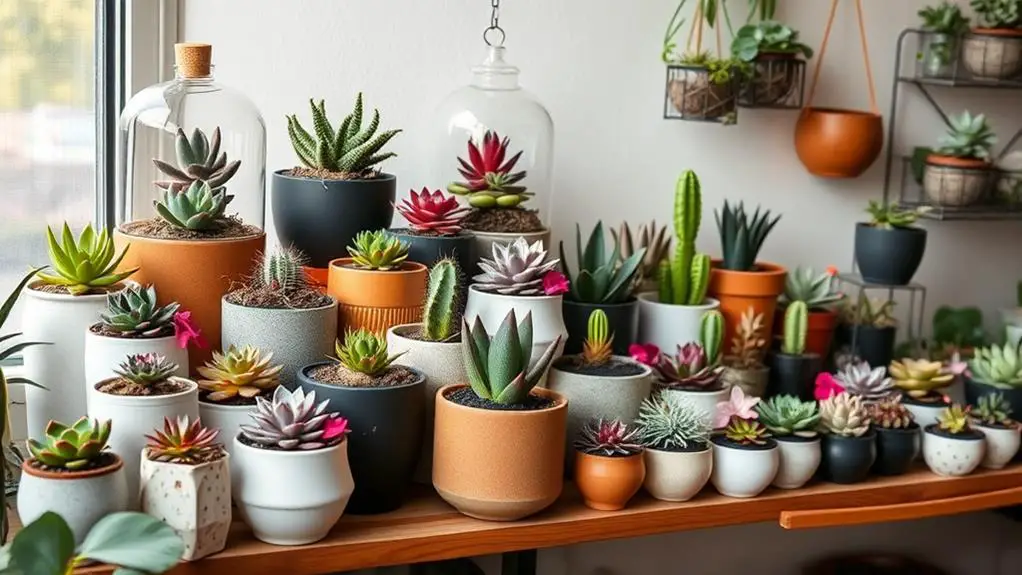
When selecting containers for your succulent arrangement, make sure they've drainage holes to prevent water buildup and root rot.
Choose materials like terracotta or ceramic, which help regulate soil moisture and allow for airflow.
Also, pick the right size and shape to match your succulents' needs—shallow pots for smaller plants and deeper ones for larger varieties.
Size and Shape Considerations
Choosing the right containers for your succulents can make a significant difference in their health and appearance.
For stunning succulent arrangements, consider the container size and shape. Larger containers can house multiple plants, while smaller ones suit single specimens or tiny groupings. The shape matters too; tall, narrow containers are perfect for vertical displays, whereas wide, shallow ones are great for grouping various succulents together.
Make certain your containers have good drainage and use well-draining soil to avoid water accumulation. Opt for breathable materials like terracotta, ceramic, or wood to promote airflow and prevent root overheating.
Drainage Hole Importance
After considering the size and shape of your containers, it's important to focus on drainage holes to guarantee your succulents thrive.
Drainage holes prevent root rot by allowing excess water to escape, ensuring the soil stays well-draining. Terracotta pots are a great choice because they let moisture evaporate and promote airflow around the roots.
Make sure the containers you choose have at least one drainage hole to handle any extra water. Avoid decorative pots without drainage holes. If you love their look, use them as outer pots and place potted succulents inside.
This way, you can maintain proper drainage and keep your plants healthy. Remember, proper drainage is key to happy, thriving succulents!
Material Choices and Benefits
Selecting the right container material is essential for the health and aesthetics of your succulent arrangements. Make sure your containers have drainage holes to prevent water pooling, which can cause root rot.
Terracotta and ceramic containers are excellent choices because they allow for proper airflow and help regulate moisture levels. If you need to move your succulents often, lightweight plastic containers are a practical option that doesn't compromise on style.
Custom containers, such as recycled wooden boxes or old teacups, add a unique touch to your display. Remember, the visual appeal of your container enhances the beauty of your succulents. Choose materials and designs that complement your plants to create stunning and healthy arrangements.
Plan Your Arrangement Design

When planning your succulent arrangement design, start by visualizing the overall theme you want to achieve—whether it's symmetrical, whimsical, or rustic.
Sketch a rough layout to clarify the size and scale of your arrangement. This helps guarantee harmony within your chosen container.
Consider color schemes, either complementary or monochromatic, to make your arrangement visually appealing.
Factor in plant height variations, placing taller ones in the back and shorter ones in the front for a layered look.
Research the light and water requirements of your plants, and group plants with similar soil conditions together.
This way, you can create a beautiful garden design that's both cohesive and thriving.
Incorporate Complementary Accessories
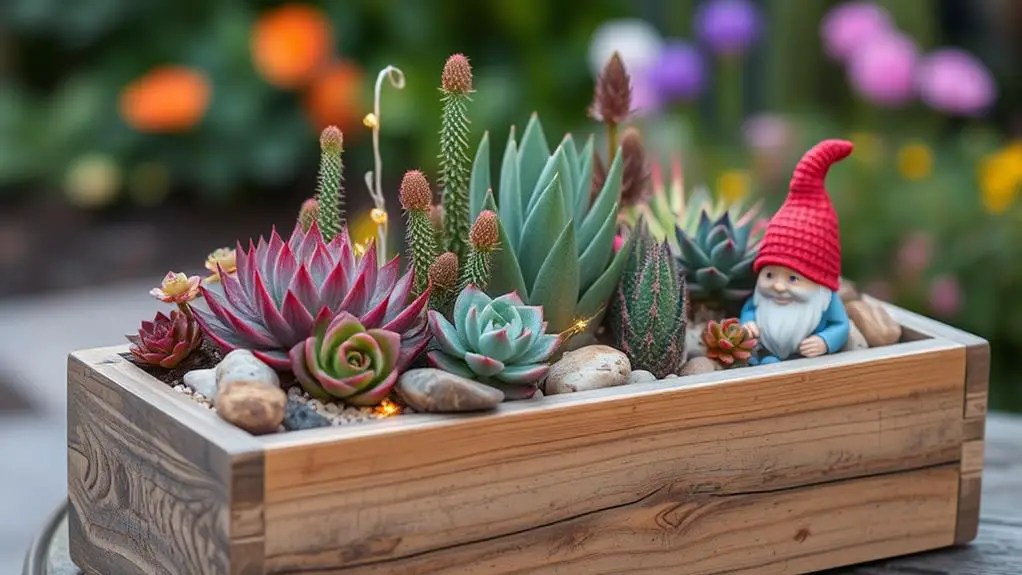
To make your succulent arrangement even more eye-catching, think about adding some complementary accessories.
Decorative stones, pebbles, or moss can introduce texture and contrast, making the succulents stand out.
You can also choose unique planters like teacups or bowls to give your arrangement a personal touch.
Decorative Stones and Pebbles
Incorporating decorative stones and pebbles into your succulent arrangements not only enhances their visual appeal but also helps retain moisture by reducing soil evaporation.
Choose stones that complement your succulents' color scheme. Light-colored pebbles can brighten darker succulents, and darker stones add depth to lighter varieties.
Adding a layer of gravel or decorative stones at the bottom of the container improves drainage, preventing water from pooling and keeping your succulents' roots healthy.
Larger, flat stones can serve as a base for taller succulents, providing stability and an artistic touch.
Natural materials like river rocks or quartz crystals offer textural contrast to the smooth leaves, enriching the overall design of your arrangement.
Moss and Natural Elements
Enhance your succulent arrangements by incorporating moss and natural elements like driftwood and shells. Moss not only boosts visual interest but also helps retain moisture in the soil, promoting healthy growth.
Adding natural elements such as decorative rocks, driftwood, or shells can make your arrangement more cohesive and visually compelling. Choose decorative rocks in varying sizes and colors to match your succulents' hues, creating texture and depth.
Layers of decorative sand or gravel on top of the soil offer a polished finish, aiding drainage and preventing soil erosion. Regularly refresh and rearrange these accessories to keep things interesting and guarantee your succulents have ample space and airflow, supporting their overall health.
Unique Planter Choices
When it comes to selecting planters for your succulent arrangements, think outside the box to create truly unique displays.
Consider unique planter choices like teacups, mason jars, or repurposed wooden crates. These add visual interest and set your stunning succulents apart.
Enhance your arrangement with decorative elements like colored gravel, seashells, or natural stones for texture and contrast.
Maximize space by using hanging planters or wall-mounted containers to create vertical gardens.
Choose containers that complement your arrangement's theme, such as rustic terracotta for a vintage feel or sleek ceramic for a modern look.
Personalize your arrangement by adding small figurines or seasonal decorations around the succulents. These touches make your display one-of-a-kind.
Maintain and Care for Your Succulents
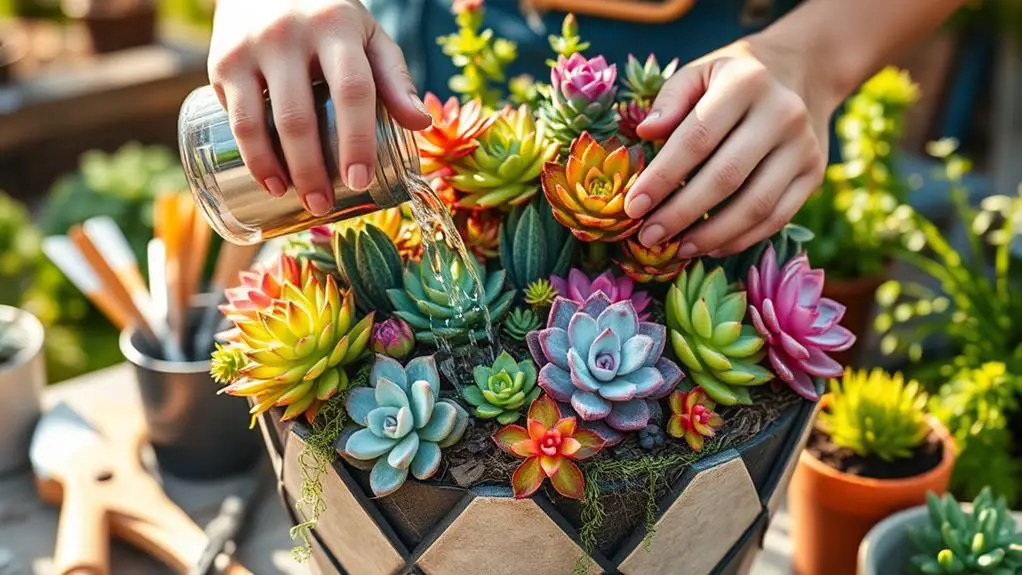
Why is succulent care so important? Proper care guarantees your succulent plants stay healthy and vibrant.
Use a well-draining soil mix with at least 50% gritty materials like perlite or pumice. This helps prevent root rot by guaranteeing water drains well.
Only water your succulents when the soil is completely dry, typically every 2-3 weeks. Place them in bright sunlight for at least 6 hours daily to avoid stretching and etiolation.
Regularly remove dead leaves to maintain freshness and improve airflow, which helps prevent pests.
During the growing season, fertilize with a balanced liquid fertilizer at 1/4 or 1/2 strength. Avoid fertilizing in winter when the plants are dormant.
Proper care makes all the difference!
Frequently Asked Questions
How to Make a Good Succulent Arrangement?
Start by picking succulents with different shapes and colors. Use the "thriller, filler, spiller" method for balance. Make sure the container drains well. Group plants with similar needs, and add decorative elements without obstructing growth.
How Do You Pick a Good Succulent?
Examine the leaves for firmness and vibrancy. Avoid any with discoloration or spots. Choose a mix of shapes, sizes, and colors. Research their growth habits and guarantee they thrive in similar conditions to create a stunning arrangement.
What Is the Most Sought After Succulent?
You're probably looking for the Echeveria, the most sought-after succulent. Its stunning rosette shape and wide variety of colors make it a favorite among collectors. You'll love its beauty and versatility in any arrangement.
How Do You Know What Succulents Can Be Planted Together?
You'll know what succulents can be planted together by matching their light, water, and temperature needs. Group them based on similar growth habits and mature sizes to guarantee they thrive and maintain a visually appealing arrangement.
Conclusion
You've got all the tips you need to create a beautiful succulent arrangement. Remember to pick diverse plants, use the right soil, and choose containers with drainage holes. Sketch your design for a balanced look, and add some decorative stones for extra flair. With a bit of planning and care, your succulents will thrive and look amazing. Follow these steps, and you'll have a stunning display that you can be proud of. Happy gardening!

